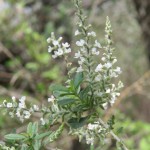Whitebrush, Beebrush, White-brush, Beebush
Aloysia gratissima (Gill. & Hook.) Troncoso
Verbenaceae (Vervain and Verbena family)
Description
Whitebrush is an aromatic shrub of the Vervain family. It reaches 3 to 10 feet or 0.9 to 3 m tall. Also called Beebrush, this shrub may grow as a single plant or in large, dense thickets. The leaves are narrow, small, pointed, pale beneath, and ¼ to 1 inch long. On the flowering branches, the leaves are smaller and smooth-edged; those on other branches are larger and toothed. The tiny flowers vary from white to blue. Bloom time occurs from March to November. Whitebrush is poisonous to horses, mules, and burros but provides fair browse for wildlife. It also provides nectar, fruit, cover, and nesting sites.Habitat
Whitebrush is frequent to abundant in Central, West, and South Texas. It grows northwest into New Mexico and south into Mexico. In far West Texas, this plant is usually restricted to draws receiving extra runoff moisture and having deep soils. Native habitat includes rocky outcrops, desert grasslands, bluffs, and open woodlands.Toxic Agent
Horses, mules and burros are suspected to have been poisoned by this plant. The toxin, although unidentified, is known to be watersoluble.Signs of Livestock Ingestion
Signs of poisoning appear to be nervous in nature and include general weight loss. Feeding experiments conducted by the Texas Agricultural Experiment Station documented these signs in horses: weakness, incoordination, and prostration. These conditions developed in sequence beginning about a month and a half after access to whitebrush, ending in death about a week after appearance of definite nervous signs.Management Strategies
A valuable honey plant, Whitebrush has minimal value as browse for other classes of livestock or wildlife. Horses fed well and given a properly developed mineral and nutritional supplementation program are much less likely to consume Whitebrush. If desired, herbicides can control this plant. For broadcast applications, apply Spike 20P® at 1 to 1.5 pounds a.i./acre in late spring to early summer. Use higher rates on heavier clay soils. For individual plant treatments, apply Velpar L® at the rate of 4 ml per 1 inch stem diameter or 3 feet of plant height. Double discing dense infestations and reseeding treated areas has reduced whitebrush by 90 percent.Images
Plant Characteristics
Flower Color: White
Seed Type: Fruit/Berry
Duration: Perennial
Stem Texture: Hairless/Smooth
Growth Habit: Shrub (Woody)
Leaf Shape
 : Simple with Pinnate or Parallel Venation
: Simple with Pinnate or Parallel Venation
Season: Warm
Distribution
 : 01 - Pineywoods, 02 - Gulf Prairies and Marshes, 03 - Post Oak Savannah, 04 - Blackland Prairies, 05 - Cross Timbers and Prairies, 06 - South Texas Plains, 07 - Edwards Plateau, 10 - Trans-Pecos
: 01 - Pineywoods, 02 - Gulf Prairies and Marshes, 03 - Post Oak Savannah, 04 - Blackland Prairies, 05 - Cross Timbers and Prairies, 06 - South Texas Plains, 07 - Edwards Plateau, 10 - Trans-Pecos
Distributions
Distribution refers to the ecological region in Texas that a plant has been found. You can also view a clickable map.
Book: Brush and Weeds of Texas Rangelands (B-6208), Toxic Plants of Texas (B-6105)
Collection: Brush and Weeds, Toxics
Livestock Affected: Horses
Livestock Signs: Depression/ Weakness, Incoordination, Loss Of Weight






